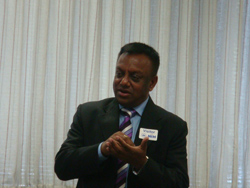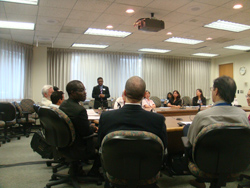Meetings and Events
Spring 2013
Vol. 8, Issue 1
Winter 2013
Vol. 7, Issue 2
Spring 2012
Vol. 7, Issue 1
Spring 2011
Vol. 6, Issue 1
Fall 2011
Vol. 6, Issue 2
Spring 2010
Vol. 5, Issue 1
Fall 2010
Vol. 5, Issue 2
Spring 2009
Vol. 4, Issue 1
Fall 2009
Vol. 4, Issue 2
Spring 2008
Vol. 3, Issue 1
Fall 2008
Vol. 3, Issue 2
Fall 2007
Vol. 2, Issue 2
Winter 2007
Vol. 2, Issue 1
Summer 2006
Vol. 1, Issue 2
Ayurvedic Medicine Formulations from India Reviewed for Cancer Treatment

presents his clinical findings to NCI
A panel of researchers and clinicians was convened by the National Cancer Institute’s (NCI) Office of Cancer Complementary and Alternative Medicine (OCCAM) on June 30, 2010 to discuss cases of cancer patients in India treated with metal-based Ayurvedic treatment (MBAT) formulations.
The meeting provided an opportunity for NCI staff and outside experts to review and discuss some of the case reports which Vaidya Balendu Prakash, an Ayurvedic practitioner from Mumbai, India had submitted via the NCI Best Case Series (BCS)( program. Director of OCCAM’s Case Review and Intramural Science Program (CRISP), Dr. Farah Zia, noted, “The NCI BCS program offers CAM practitioners expert assistance in identifying and compiling persuasive case studies as well as the opportunity to have their data evaluated by NCI. The goal of the program is to make a determination about whether or not NCI-initiated research is warranted.”
Mr. Prakash provided background on his practice of Rasa-Chikista, a branch of the ancient Indian Ayurvedic medicine system, which uses compounds made of various combinations of native plants, animal products, and metals (mercury, gold, silver, copper, iron, tin, lead, and zinc). The ayurvedic compounds are created through a “tedious method of preparation” of grinding, heating and combining the various compounds that can take 2-3 years to complete for each batch, he noted.
Mr. Prakash learned about the preparation and use of ayurvedic medicines from his father, an Ayurvedic physician who used one of the compounds to treat cancer for the first time in 1973 in a 38-year-old man with pancreatic cancer. The patient, who was considered terminally ill, had noticeably improved after six months treatment, and he remains alive today, Mr. Prakash reported. Despite this success, his father was unable to consistently replicate the results with other cancer patients, which Mr. Prakash later understood was probably due to batch variations in the ayurvedic formulation process.
After the death of his father, Mr. Prakash decided to prepare the same ayurvedic medicines while documenting the process and has used these preparations on many cancer patients. He presented findings from case studies of 14 patients with different leukemias and solid tumors treated with ayurvedic compounds . The typical treatment lasts 5-7 years, Mr. Prakash noted. He reported uniformly positive responses and long-term survival for most of the patients.
Dr. Irina Maric, a pathologist at the National Institutes of Health (NIH) Clinical Center, reviewed cytology slides from a few of Mr. Prakash’s case studies, that include patients who were treated by him in the late 1990s. “The slides are about 13-years-old now, and there is marked degradation of the material in the slides and very poor preservation,” she said, making confirmation of the patients’ diagnoses very difficult. Mr. Prakash apologized and noted he usually was unable to get good quality slides and pathology reports from the hospitals his patients had attended before, during, and after ayurvedic treatment.

lively roundtable discussion.
Dr. David Newman, director of NCI’s Natural Products Branch, questioned Mr. Prakash about the controls and standardization used in the ayurvedic formulation process. Dr. Newman also asked if Mr. Prakash conducted chemical analyses of the individual batches of the ayurvedic compounds to help identify what specific chemicals may be causing the responses in the cancer patients. Mr. Prakash said he has taken steps to achieve standardization of the batches, monitoring and controlling the temperatures used in melting and combining the various ingredients, including the metals used in creating the ayurvedic medicines. However, he acknowledged that he has not done chemical analyses of his ayurvedic compounds but that he is currently in discussions with a center in India to do so.
The remainder of the discussion explored Mr. Prakash’s past attempts and future plans to participate in collaborative clinical research projects and the kind of information that would be necessary to complete the NIH Best Case Series review, OCCAM’s director, Dr. Jeffrey White promised to follow up with Mr. Prakash to request additional data and case studies of more recent patients and to make suggestions for next steps in NCI’s evaluation of the ayurvedic compounds. Such investigations fit with the Institute’s goal in CAM research to study novel therapeutics in the pharmacopoeia of traditional medical systems around the world, Dr. White said.





